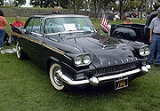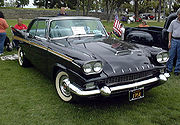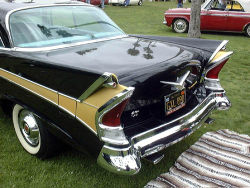
1957 and 1958 Packards
Encyclopedia
The 1957 and 1958 Packard lineup of automobiles were actually Studebaker
s: mildly restyled, rebadged and given slightly more luxurious interiors. After 1956 production, the Packard
engine and transmission factory was leased to the Curtiss-Wright
Corporation while the assembly plant on Detroit
's East Grand Boulevard was sold, ending the line of Packard-built cars. However, some Studebaker executives still saw value in the Packard name. These cars were developed in hopes that enough would be sold to enable the company to design and build a completely new luxury Packard.
, and added a revised grille and taillights along with a machine-turned look dashboard and called the car the Packard Clipper. Two models were produced in 1957, a four-door Town Sedan and a station wagon Clipper Country Sedan. Taillights were borrowed from the 1956 Clipper, while the headlight 'eyebrows', hubcaps, dashboard and interior were all Packard styled (In fact, most were merely styled to give the "Packard look" while fitting onto a Studebaker, but a few actually were leftover Packard parts).
When Packard dealers saw the resulting car at regional previews, the response was quick, angry and loud. Many dealers felt the Clipper was too similar to the Studebaker on which it was based and dropped Packard completely. Sales were a low 4,809, almost all of which were the Town Sedan. Critics bestowed the less than positive name "Packardbaker
" on the cars.
In order to produce an engine of appropriate power for a Packard, a McCulloch-supercharged
version of Studebaker's 289 in³ (4.7 L) small-block V8 was used, giving 275 bhp (205 kW), equivalent to the Packard engines in use the year before (and likewise used in the Studebaker Golden Hawk
). Since the Studebaker-bodied cars were quite a bit lighter than the previous year's Packards, the 1957 Packard range actually had quite exceptional performance for the time.
Writer and auto historian Richard Langworth has noted that while these cars weren't truly Packards, they were, however, very good Studebakers.
 1958 saw the Packard line reduced to two models and four body styles; a 4-door sedan, a 2-door hardtop coupe (sometimes referred to as the "Starlight", a name used by Studebaker), a 4-door station wagon which simply bore the Packard name, and the Packard Hawk
1958 saw the Packard line reduced to two models and four body styles; a 4-door sedan, a 2-door hardtop coupe (sometimes referred to as the "Starlight", a name used by Studebaker), a 4-door station wagon which simply bore the Packard name, and the Packard Hawk
, a modification of Studebaker's Golden Hawk
with a "fishmouth" Packard grille.
Restyled by Duncan McRae
, Studebaker-Packard's finances dictated that the changes for 1958 be made as cheaply as possible. Quad headlights were achieved by affixing fiberglass
pods to the previous year's front fenders designed for two headlights. In the rear, McRae attempted to follow the tailfin craze established by Chrysler's 1957 "Forward Look" by crafting outward canted fiberglass fin extensions that were mounted to the tops of the existing vertical rear fenders. 1956 Clipper taillight units continued to be used. Packards also adopted a low, wide "fishmouth" grille to further distinguish them from their Studebaker cousins.
 Despite McRae's efforts, the car that emerged appeared cobbled together, rather than as a cohesive design. Auto reviewer "Uncle" Tom McCahill remarked that from the rear it looked as if the cars had been left in the sun too long and the canted fiberglass fins had started to melt down the straight rear fender sides.
Despite McRae's efforts, the car that emerged appeared cobbled together, rather than as a cohesive design. Auto reviewer "Uncle" Tom McCahill remarked that from the rear it looked as if the cars had been left in the sun too long and the canted fiberglass fins had started to melt down the straight rear fender sides.
Only 2,034 of the three standard models (sedan, hardtop and station wagon) were produced; an additional 588 Packard Hawks were built as well. The rarest of all '58 Packards is the station wagon
, with only 159 produced. The last Packard rolled off the South Bend
assembly line on July 13, 1958.
In 1962 the Studebaker-Packard Corporation officially dropped "Packard" from its name.
".
Studebaker
Studebaker Corporation was a United States wagon and automobile manufacturer based in South Bend, Indiana. Founded in 1852 and incorporated in 1868 under the name of the Studebaker Brothers Manufacturing Company, the company was originally a producer of wagons for farmers, miners, and the...
s: mildly restyled, rebadged and given slightly more luxurious interiors. After 1956 production, the Packard
Packard
Packard was an American luxury-type automobile marque built by the Packard Motor Car Company of Detroit, Michigan, and later by the Studebaker-Packard Corporation of South Bend, Indiana...
engine and transmission factory was leased to the Curtiss-Wright
Curtiss-Wright
The Curtiss-Wright Corporation was the largest aircraft manufacturer in the United States at the end of World War II, but has evolved to largely become a component manufacturer, specializing in actuators, aircraft controls, valves, and metalworking....
Corporation while the assembly plant on Detroit
Detroit, Michigan
Detroit is the major city among the primary cultural, financial, and transportation centers in the Metro Detroit area, a region of 5.2 million people. As the seat of Wayne County, the city of Detroit is the largest city in the U.S. state of Michigan and serves as a major port on the Detroit River...
's East Grand Boulevard was sold, ending the line of Packard-built cars. However, some Studebaker executives still saw value in the Packard name. These cars were developed in hopes that enough would be sold to enable the company to design and build a completely new luxury Packard.
1957 Packard Clipper
For the 1957 model year, Studebaker-Packard took its top-of-the-line model, the PresidentStudebaker President
The Studebaker President was the premier automobile model manufactured by the Studebaker Corporation of South Bend, Indiana from 1926-1942. The nameplate was reintroduced in 1955 and used until the end of the 1958 model when the name was retired....
, and added a revised grille and taillights along with a machine-turned look dashboard and called the car the Packard Clipper. Two models were produced in 1957, a four-door Town Sedan and a station wagon Clipper Country Sedan. Taillights were borrowed from the 1956 Clipper, while the headlight 'eyebrows', hubcaps, dashboard and interior were all Packard styled (In fact, most were merely styled to give the "Packard look" while fitting onto a Studebaker, but a few actually were leftover Packard parts).
When Packard dealers saw the resulting car at regional previews, the response was quick, angry and loud. Many dealers felt the Clipper was too similar to the Studebaker on which it was based and dropped Packard completely. Sales were a low 4,809, almost all of which were the Town Sedan. Critics bestowed the less than positive name "Packardbaker
Packardbaker
Packardbaker is a derisive slang term applied to 1957 and 1958 model year Packard automobiles. The word's origin came from detractors of Studebaker-Packard Corporation's attempt to continue the Packard brand with models that were derived from the Studebaker President body shell and running...
" on the cars.
In order to produce an engine of appropriate power for a Packard, a McCulloch-supercharged
Supercharger
A supercharger is an air compressor used for forced induction of an internal combustion engine.The greater mass flow-rate provides more oxygen to support combustion than would be available in a naturally aspirated engine, which allows more fuel to be burned and more work to be done per cycle,...
version of Studebaker's 289 in³ (4.7 L) small-block V8 was used, giving 275 bhp (205 kW), equivalent to the Packard engines in use the year before (and likewise used in the Studebaker Golden Hawk
Studebaker Golden Hawk
The Studebaker Golden Hawk is a two-door pillarless hardtop coupe type car produced by the Studebaker Corporation of South Bend, Indiana between 1956 and 1958.-Styling:...
). Since the Studebaker-bodied cars were quite a bit lighter than the previous year's Packards, the 1957 Packard range actually had quite exceptional performance for the time.
Writer and auto historian Richard Langworth has noted that while these cars weren't truly Packards, they were, however, very good Studebakers.
Final Packards

Packard Hawk
The 1958 Packard Hawk was the sportiest of the four Packard-badged Studebakers produced in the final year of Packard production,. Packard's plant in Detroit, Michigan had been leased to Curtiss-Wright , and Packard models in this dying-gasp year were all rebadged and retrimmed Studebaker products...
, a modification of Studebaker's Golden Hawk
Studebaker Golden Hawk
The Studebaker Golden Hawk is a two-door pillarless hardtop coupe type car produced by the Studebaker Corporation of South Bend, Indiana between 1956 and 1958.-Styling:...
with a "fishmouth" Packard grille.
Restyled by Duncan McRae
Duncan McRae
Duncan McRae may refer to:*Duncan McRae , Australian former rugby footballer*Duncan McRae , Scottish-Canadian politician*Duncan John McRae, Red Baron's 19th victory....
, Studebaker-Packard's finances dictated that the changes for 1958 be made as cheaply as possible. Quad headlights were achieved by affixing fiberglass
Fiberglass
Glass fiber is a material consisting of numerous extremely fine fibers of glass.Glassmakers throughout history have experimented with glass fibers, but mass manufacture of glass fiber was only made possible with the invention of finer machine tooling...
pods to the previous year's front fenders designed for two headlights. In the rear, McRae attempted to follow the tailfin craze established by Chrysler's 1957 "Forward Look" by crafting outward canted fiberglass fin extensions that were mounted to the tops of the existing vertical rear fenders. 1956 Clipper taillight units continued to be used. Packards also adopted a low, wide "fishmouth" grille to further distinguish them from their Studebaker cousins.

Only 2,034 of the three standard models (sedan, hardtop and station wagon) were produced; an additional 588 Packard Hawks were built as well. The rarest of all '58 Packards is the station wagon
Station wagon
A station wagon is a body style variant of a sedan/saloon with its roof extended rearward over a shared passenger/cargo volume with access at the back via a third or fifth door , instead of a trunk lid...
, with only 159 produced. The last Packard rolled off the South Bend
South Bend, Indiana
The city of South Bend is the county seat of St. Joseph County, Indiana, United States, on the St. Joseph River near its southernmost bend, from which it derives its name. As of the 2010 Census, the city had a total of 101,168 residents; its Metropolitan Statistical Area had a population of 316,663...
assembly line on July 13, 1958.
In 1962 the Studebaker-Packard Corporation officially dropped "Packard" from its name.
Trivia
A pink purple and gold 1958 Packard station wagon is seen in the 2001 motion picture "Hearts in AtlantisHearts in Atlantis
Hearts in Atlantis is a collection of two novellas and three short stories by Stephen King, all connected to one another by recurring characters and taking place in roughly chronological order....
".

